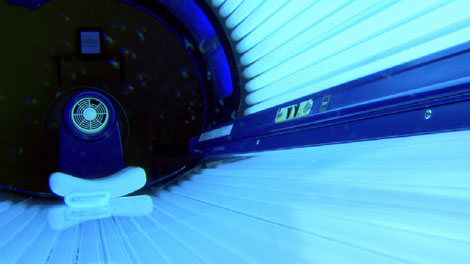
An article released today in the American Journal of Preventative Medicine by Holman et al. focuses on strategies to reduce indoor tanning. Indoor tanning with sun lamps (as opposed to spray tanning) increases the risk of malignant melanoma, the deadliest form of skin cancer. This is particularly alarming because about one-third of white women(who are a high risk for skin cancer than others) in the U.S. have used sun lamps to tan within the past year averaging about 27 sessions over that time. Many indoor tanning salon users are at even greater risk for skin cancer because 74% of tanning salons fail to adhere to FDA guidelines for tanning frequency. The International Agency for Research on Cancer recently elevated tanning beds to its highest risk category as carcinogenic to humans. Only 2 states prohibit tanning by minors (CA and VT).
There are some similarities between the way the indoor tanning and tobacco industries operate. In fact, it appears that the tanning industry may be following the tobacco industry’s lead, particularly in its use of front groups and creating doubt around the science around the harm their products cause.
In 2010, the Federal Trade Commission settled a complaint against the Indoor Tanning Association for making deceptive claims about the risks and the benefits of indoor tanning.
In addition to legislative approaches to the problem and addressing research needs, one important intervention would be for the Food and Drug Administration to change the medical device classification for sunlamp products from class I to class II. Class I is the medical device class used for tongue depressors. Today, the FDA pre-published proposed rules to reclassify sunlamps as class II devices (they will be published on May 9, 2013 and available here). Class II medical devices include products such as infusion pumps and surgical drapes.
Under the rules proposed today, manufacturers would have to: a) demonstrate to the FDA that indoor tanning lamps are safe for individuals; b) adjust UV wavelength to “appropriate” levels; c) install alarms and timers to prevent sunburn; and d) require users to read labels warning them of the dangers of UV exposure, including discouraging individuals under the age of 18 or those with a family history of cancer. Not only will these new requirements improve safety and reduce exposure to UV radiation indoors, they will also provide a strong reason for states to consider passing new or strengthening existing laws regulating tanning salons.
See: Strategies to Reduce Indoor Tanning: Current Research Gaps and Future Opportunities for Prevention, by Dawn M. Holman, MPH; Kathleen A Fox, MPP; Jeffrey D. Glenn, MPA; Gery P. Guy, Jr., PhD; Meg Watson, MPH; Katie Baker, MPH, DrPH(c); Vilma Cokkinides, PhD; Mark Gottlieb, JD; DeAnn Lazovich, PhD; Frank M Perna, EdD, PhD; Blake P Sampson, BS; Andrew B. Seidenberg, MPH; Craig Sinclair; Alan C. Geller, MPH, RN (DOI: 10.1016/j.amepre.2013.02.014)
